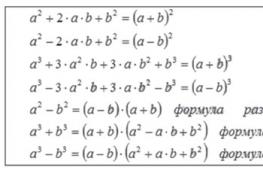Types of architectural styles in the interior. Styles and trends in modern architecture and design
Development of a design project in a specific architectural style is extremely important for the Customer:
1. This allows you to get a high quality interior.
2. Stylish interior significantly increases the value of real estate.
Interior architectural styles
Romanesque (950-1250)
- Character traits:
relief plane, laconicism and simplicity. Painting (a lot of religion). Floor - marble, patterned tiles. Mirrors - chiffon bronze. Walls - Venetian plaster. Striving to show not visual beauty, but the true beauty of the spirit.
Prevailing colors: brown, red, green, white.
Lines: barrel, semicircular, straight, horizontal and vertical.
The form:
rectangular and cylindrical.
Interior elements:
semicircular frieze, a repeating geometric or floral pattern; halls with exposed ceiling beams and pillars in the center.
Constructions:
stone, massive, thick-walled; wooden plastered with visible skeleton.
Window:
rectangular, small, in stone houses - arched.
Doors:
plank, rectangular with massive hinges, lock and bolt.
Gothic (1250-1520)
- Character traits:
city, chivalry, carnival. Drapery appeared. Blue glass in wide windows. Impressions of narrow streets ending in a cathedral looking into the sky.
Prevailing colors:
yellow, red, blue.
Lines:
lancet, forming a vault of two intersecting arcs, ribbed repeating lines.
The form:
rectangular buildings; pointed arches turning into pillars.
Interior elements:
fan vault with supports or coffered ceiling and wooden wall panels; foliage complex ornament; the halls are high, narrow and long, or wide with supports in the center.
Constructions:
frame, openwork, stone; elongated upward pointed arches; underlined skeleton of structures.
Window:
extended upwards, often with multicolored stained-glass windows; at the top of the building there are sometimes round decorative windows.
Doors:
lancet ribbed arches of doorways; oak paneled doors.
Renaissance (Revival) (1520-1650)
- Character traits:
leafy ornament; decoration of cathedrals, churches and cathedrals - painting of walls and ceilings. The shape of the furniture is simple, geometric, solid and richly decorated.
Prevailing colors:
purple, blue, yellow, brown.
Lines:
semicircular lines, geometric patterns (circle, square, cross, octagon), predominantly horizontal division of the interior.
The form:
steep or sloping roof with tower superstructures, arched galleries, colonnades, round ribbed domes, high and spacious halls, bay windows.
Interior elements:
coffered ceiling; antique sculptures; leafy ornament; painting of walls and ceiling.
Constructions:
massive and visually stable; diamond rust on the facade.
Window:
semicircular and rectangular with a heavy cornice and frieze in combination with round; sometimes semicircular arched, often paired and even triple.
Doors:
arrangement of portals with a heavy cornice, frieze and columns; rectangular and semicircular arched entrance.
Baroque (Rococo) (1650-1770)
- Character traits:
symmetry in style, spaciousness. A lot of stucco. Complex surfaces of the plane in buildings, large new structures in columns, frenziedly finished ceilings with recessed parts.
Rococo -
more graceful and sophisticated style. The presence of graceful "unstable" furniture made of wood, amenable to carvings with beautiful veneers and varnished. The walls were decorated with mirrors and fully decorated. Lack of straight lines and angles. Things are inlaid with a delicate floral pattern. Style "frivolous" with elements of eroticism. A graceful, whimsical ornamental rhythm dominates. The interiors are graceful, decorative, lightweight. The decorative art of Rococo belongs to the highest achievements of the 18th century art in terms of sophistication, beauty of asymmetric compositions, in the spirit of intimacy, comfort and personal convenience.
Prevailing colors:
muted pastel colors; red, pink, white, blue with a yellow accent.
Lines:
bizarre convex-concave asymmetric pattern; in the form of a semicircle, rectangle, oval; vertical lines of columns; pronounced horizontal division.
The form:
vaulted, domed and rectangular; towers, balconies, bay windows.
Interior elements:
striving for greatness and pomp; massive front stairs; columns, pilasters, sculptures, stucco and painting, carved ornament; interconnection of design elements.
Constructions:
contrasting, tense, dynamic; pretentious on the facade and at the same time massive and stable.
Window:
semicircular and rectangular; with floral decorations around the perimeter.
Doors:
arched openings with columns; vegetable decor.
Classicism (Empire) (1770-1840)
- Character traits: -
A style that turned to the ancient heritage as a norm and an ideal model. Restrained decor and expensive high-quality materials ( natural wood, stone, silk, etc.). The most common decorations are sculptures and stucco.
Empire style -
display of symbols with a military theme (military emblems, ornament of balls, shields, hats). The presence of pathos in everything; manifestation in the forms of animal paws - griffins, lions, sphinxes. The floor is finished with parquet; decorative elements are located at the edges and corners of light ceilings; the walls are draped with fabrics. Elements are gilded. The fabric, especially the waxed chintz, often predominates. The furniture is comfortable and soft and accessories are everywhere - books, candles, flowers, lamps and antiques. For solid and conservative people.
Prevailing colors:
saturated colors; green, pink, purple with gold accents, sky blue.
Lines:
strict repeating vertical and horizontal lines; a bas-relief in a round medallion; smooth generalized drawing; symmetry.
The form:
clarity and geometry of forms; roof statues, rotunda; for the Empire style - expressive pompous monumental forms.
Interior elements:
discreet decor; round and ribbed columns, pilasters, statues, antique ornament, coffered vault; for the Empire style - military decor (emblems); symbols of power.
Constructions:
massive, stable, monumental, rectangular, arched.
Window:
rectangular, elongated upward, with a modest design.
Doors:
rectangular, paneled; with a massive gable portal on round and ribbed columns; with lions, sphinxes and statues.
Historicism (Neo-Baroque, Modern, Rationalism) (1840-1918)
- Prevailing colors:
dim light colors; lilac, light green, brown.
Lines:
a combination of thin and thick lines; vertical; horizontal; smoothly flowing, varying in thickness.
The form:
laconic; rectangular, spherical, cylindrical, an abundance of bay windows, verandas, loggias, balconies.
Interior elements:
figurative-symbolic, dynamic, wriggling pattern in modern and geometric in rationalism; stylized floral pattern.
Constructions:
steel and reinforced concrete beam spatial and lattice.
Window: wide rectangular and oval.
Doors:
rectangular, paneled, wooden, glass, metal.
Postmodernism (since 1918)
- Character traits: -
A fusion of various styles of the past is used, for example, classical and baroque, often using them with an ironic effect. The specificity of the style is hyperbole as a tool for creating a vivid theatrical image of the environment. Moving away from Modernism, Postmodernism seeks to bring uncertainty and contrast to the order and simplicity of contemporary styles. Design often connects color with a historical reference.
Prevailing colors:
beige, silver, metallic, pearlescent, fluorescent.
Lines:
dynamic, free.
The form:
rational and free; symmetrical and asymmetrical; transforms.
Interior elements:
large, spacious halls; light, original designs; contrasting textural and textured combinations. Application artificial leather, nickel-plated and chrome-plated materials.
Constructions:
unified prefabricated and dismountable; logical and appropriate; lightweight aluminum and traditional reinforced concrete; arched, beam and cable-stayed.
Window:
spacious, sometimes the entire wall; sliding, folding, swing and swivel.
Doors:
telescopic, sliding, folded, swinging, balancing, rotating, etc.
Neoclassicism
- Character traits: -
Based on classical Greek and Roman forms and popular from the late 18th century to the mid-19th century. This furniture is light and graceful with straight lines. Common decorations are leaf acanthus, shells, architectural pediments and classic figures. This style is close to Empire and Biedermeier. Neoclassicism of the 20th century goes back to neoclassicism of the 17th-18th centuries. with his appeal to the ancient Greek and Roman styles. Modern use of classical motifs includes both strict antique and more lush and whimsical forms inherent in Empire and Rococo. The neoclassical decor is characterized by images of acanthus leaves, shells, and architectural fragments.
Biedermeier (early twentieth century)
- Character traits: -
Good quality, comfort and practicality. This is a style of urban life (clubs, museums, institutions). The interior has been simplified (reduced in size). There were curtains, tulle, cheap upholstery fabrics, tablecloths, picturesque "simple" prints on the walls. The feeling of a "clean" room, with a certain provinciality. Availability of porcelain figures and busts. The style is defined by classic simple lines and light woods accentuated by black touches. The classic, as it were, graphic lines of these things make it easy to combine them with any style.
Modern (late XIX - early XX centuries)
- Character traits:-
He introduced fundamentally new decorative elements into the interior design, giving them preference over constructive ones. The decoration pays great attention to the stylized floral pattern, flexible fluid forms. Versatile, synthetic style, most popular in modern design interiors. The principle of style is dynamic balance with optically flexible shapes. New materials are used: reinforced concrete, glass, ceramics, unplastered bricks, mosaics, many metal structures... Modern furniture is simple, without unnecessary decorations, and functional. In design, the term Modern can be confusing as it is used both to refer to this particular style and as a traditional definition. Mid-century modern is now a popular term for furniture and things from about the mid-40s to 60s of our century. The lines are simple and clean, functionality comes first, finishes are usually light, decorations are either missing or oversimplified.
Romanticism - The appeal is rather to folklore and natural forms of decor. Wild stone, forging, Gothic forms of openings, green corners, etc. It is considered characteristic of poetic natures.
Art Nouveau - A style that spread in France and Europe at the end of the 19th century, with flowing ornate lines. Nature was often a source of inspiration, and themes such as flowers, leaves, birds and insects were common. These images of wildlife were often fabulous and asymmetrical. Women in long dresses with long flowing hair are also typical of this style. Emphasizes the bright personality of the wearer.
Neo-modern- The use of Art Nouveau plastic forms for the architectural design of premises on a modern technological base. Almost complete absence of ornaments.
Bauhaus - In the 1920s and 1930s, this German school of design laid the foundation for what would later be called "Art Nouveau" or Modernism. Based on the now popular philosophy of "form is determined by function", the Bauhaus forms were simple, light, without unnecessary decorations. Popular materials include tubular steel, plywood, leather, and plastic. The palette is usually limited to black, white, brown, and gray.
Miami - He was influenced by American folk art and the design of the rapidly developing machine and aircraft industry at that time. This style is characterized by rounded corners, strict vertical lines, and "receding" shapes. It is distinguished from all furniture styles by the use of decorative elements in the form of zigzags, circles, triangles, suns. Common materials include exotic woods, plastic laminates, chrome and stainless steel. The lightness and grace of the decor trying to absorb the speed and pressure of the coming age of machines. Wide field to showcase good taste.
Global - A characteristic element for a variety of styles including influences from foreign and exotic locations. Something equivalent to Exotic or Ethnic styles, often elements from Africa, Polynesia, India and Asia. Global styles often include primitive art and ritual objects, animal skins, decorative shingles, handcrafted metal, plant materials such as raffia, seaweed, water hyacinth, and bamboo. Influence from North Africa, Tibet and Turkey is gaining in popularity.
Global modern - it is any style that combines the clean lines of modernity with a global sensibility. Things in this style have become widespread, so the choice of specific products will not be difficult. Large thickened forms are characteristic, decoration and accessories, on the contrary, are small and in limited quantities. If you like frills and ruffles, forget about them. The silhouette of the room should be simple and economical, but also comfortable. This is not the ideal of minimalism, but a rich and exotic simplicity. The furnishings should be dominated by mid-century modern style according to the 70/30 mixing rules. The contrast in this style comes from color, texture and workmanship. Details can be dark or light, uneven or smooth, but they should all have some kind of unifying elements.
Industrial - Furniture originating from the "Industrial Age" and usually metal - chrome, stainless steel, etc. Surfaces can be lightly or highly polished. Many of these things were actually used in factories and offices in the early or mid 20th century. Typically, these are desks, bar stools, bookcases and file cabinets, folding chairs and handy carts. This style is usually too cold to be used alone. Closely adheres to minimalism. Industrial style - with open, sterile spaces, like from a fantastic movie. Metal objects that resemble fantastic appliances and equipment.
Country Industrial - A combination of styles characterized by the contrast between smooth industrial surfaces and rough or old-fashioned rustic details - usually worn wood and others natural materials... Combining country with simple, clean lines of industrial style creates a very comfortable and functional connection. Sturdy, easy-to-clean surfaces with vertical drops and sleek details work well with purposely rough wood, wicker baskets and small mats. This style matches the desire of many people to have a modern environment warmed by the warmth of nature. It is a mix based on the contrast of textures and materials. The color palette of the interior should be uniform, muted gray, brown, golden and soft blue and green shades. Continuous fluidity of color focuses attention on the difference in textures and materials. The coolness of the metal contrasts with the warmth of natural wood and fabric.
Memphis - Having done away with the order and logic of early modernism, Memphis's style was highly anti-design - playful, illogical, flamboyant, and often had a "bad taste". Colors were out of tune, proportions were out of order, corners and edges were sharpened, yet the furniture was and remains exciting, witty and fun. Memphis proclaims: "Don't take design too seriously." The style is characterized by the presence of ordered areas of empty space, where everything is coordinated. Completeness is the keyword for this style. The external attributes of everyday life are hidden, the palette is usually neutral and monochrome. Exact implementations of this style are rare and are best reserved for institutions and museums.
Exotic- Interiors furnished and decorated with stylized or authentic objects of ethnic cultures in their most striking and unusual manifestations with echoes of a distant and unknown life.
Asiatic - Also called "Zen" or "Far East", the keywords are order, balance, clarity and simplicity. Texture, neutral palette and emphasis on the concept of a home as a sanctuary are all important. It's definitely less is more style.
English village - An elegant yet cozy style combining new and old elements. Fabric, especially waxed chintz, often predominates, furniture is comfortable and soft, and accessories are everywhere - books, candles, flowers, lamps and antiques. Modern interpretations of this style are cleaner and more neutral - for example, the Shabby Chic style.
Bohemian - Demonstrates ample evidence of artistic and literary aspirations and disregard for convention. The patterns are often rich and incongruous, beads and beads are typical, and European influences are abundant. It's about mixing many styles and periods, guided by art and intelligence.
British colonial - With its casual elegance, the British Colonial style became very popular. While wood can be dark, the overall feel is light and airy thanks to the abundance of free space and light-colored fabrics and walls. The furniture, both original and reproduced, is meticulously carved and at times massive, but the rest of the elements are usually simple and light. Tropical accessories stand out against muted earthy tones.
Victorian - With its characteristic heavy decorations, this style was popular during the period 1840-1900. Named after Queen Victoria, Victorian furniture is usually heavy, dark and intricately carved. Thoughtful mixing of Victorian things with more modern ones can enhance the beauty of both.
Colonial - Formal or casual, simple or elaborate, Colonial furniture refers to American furniture from the "Colonial" period - circa 1700s. A variety of wood species - from pine to mahogany.
Missionary - Also called Arts and Crafts, this style lasted from the late 19th century to the 1920s and proclaimed the purity of simple lines, rectangular and often blocky shapes, visible joints and seams. The authenticity of the design is exalted. Arts and Crafts was actually the first style to combine industrial production with craftsmanship. handmade... The "apparent heaviness" of these things is balanced when combined with other styles.
Primitivism - Spontaneous, natural and simple - these are the key words in primitivism. The items are often made by self-taught artists or handcrafted as needed. Good texture or patina often attracts in these pieces, creating a sense of honesty and functionality. Primitivism goes well with modern styles and makes a pleasant contrast to smooth surfaces. Many of the items used to create the Country-Industrial style are Primitivism.
Rustic - The Primitivist-like style is typical of rural life and often involves the feeling of a mountain hut, forest retreat, or ranch house. Hickory or snowshoe furniture, antler candelabra and oversized stuffed chairs are typical of the Rustic style.
Southwest - The most common style in the southwestern United States, includes the Santa Fe, Mexican, and American Indian styles. Typical signs of this style are dull earthy colors, terracotta ceramics and heavy, rough wood furniture.
Scandinavian - There are many styles of Scandinavian furniture, however, most of them are simple, light, usually devoid of ornaments. The colors are light, the proportions are pleasant. Most typically pale wood with a painted finish. Scandinavian usually mixes well with other styles.
Flea market - The key to Flea Market style is creating a truly personal home. By using items brought from flea markets, private sales and specialty stores, you can mix origins, decades, and styles in a completely unique way. New things can of course be combined with "finds", however, the latter should prevail. And remember that even a Flea Market style house needs some kind of theme and impetus for creativity.
French village - Imagine white sheer curtains, an old wardrobe, an oak or pine rustic table with incongruous painted chairs, and medicinal plants on the windowsill. There are many perceptions of the French countryside, but they tend to be based on good food, drink and simple rustic comforts. The main thing is what they eat in the area. Earthy and washed out colors - terracotta, umber, blue, etc. And the surfaces are natural - stone, tiles, wood and clay.
Chipendale - Named after Thomas Chippendale, this late 19th century style is elegant and formal. Fancy details, balls, clawed paws and curved legs are typical. Be careful when mixing these things with other styles.
Shaker - Definitely a rustic style. The furniture has simple but beautiful outlines. Comes from an American religious sect, 18th and 19th century.
Minimalism - Extreme laconic form, complete absence of decor, ornaments or detailing of the facade finish. Clarity of composition, monochrome, emphasizing natural textures. Work with large planes, graphic quality. In furniture, minimalism is characterized by the most modern materials: steel, frosted glass, natural wood, aluminum profiles. Emphasizes the primitiveness of forms, reducing them mainly to geometric shapes. Open spaces are cultivated in the interior. All manifestations of everyday life are carefully hidden. The coldness and inaccessibility of the required perfection in everyday life make this style more suitable for public places.
Modern - A style that spread in the late 20th century characterized by rounded and softened lines and smooth surfaces. Often used as a generic way of expressing something without explicit historical reference.
Traditional -
It is customary to refer to the traditional ones as respectable interiors that embody the bourgeois order of life. This is solid, solid furniture in the style of past eras, an interior consisting of items that always have a historical identity.
Kitsch -
The combined name of some movements of postmodernism, such as Memphis, using the potential of bad taste and the charm of sentimental crafts of mass demand. This is an anti-design game that emerged as a protest movement in interior fashion for those who are ready to take their environment not too seriously.
Eclecticism -
The use of furniture of a mixed style or a combination of objects of different origins, styles and times. Eclecticism becomes a style in the interior if it is designed according to the principle of combining no more than two or three stylistic types, united by color, texture, and architectural solution. A mix of details gleaned from various sources, styles and periods.
Techno-Art - Absolutizing the technological aspect. Highlighting load-bearing structures and communications. Often - an imitation of the latter.
High tech - The style of the late twentieth century, the main features of which are the maximum functional use of space and discreet decor. The style is characterized by swift, straight lines, an abundance of glass and metal details.
I decided to write an article about styles in architecture and design at the present stage, and not so distant past. Styles from the last century have become not only a source of inspiration for modern architects and designers, but also a full-fledged component of modern culture. Today, architects and designers are faced with a wide variety of artistic media and stylistic aspects. They can mix styles from the past with styles of the present in search of the future. In modern times, architectural design does not simply define the shape of an object or its function. It has become an independent language of creativity. And like any language, you need to learn it in order to use it effectively.
We live in a society constantly faced with the problem of choice, surrounded by objects whose aesthetic properties are valued no less than functional ones. This is the consumer world. Going towards modern society and in response to his changing desires, architects and designers are increasingly turning to historical styles for inspiration. In the 19th century, historical styles played a leading role in art, in the 20th, Art Nouveau put an end to their dominance. Modernists strove to create their own artistic language and completely rejected styles from the past. And only in the 1960s, with the advent of postmodernism, architects and designers began to turn to history again. As they say, new is well forgotten old.
Art Nouveau is the name of a universal style that emerged in Europe in the late 1880s, at a time when designers and architects were looking for something new to base their work on. Art Nouveau rejected historical styles and for this reason was considered the first truly modernist style. Plant motifs, sinusoids, non-geometric curves are considered the main forms of Art Nouveau.
Staircase "Horta House", Brussels, Belgium; Victor Horta. 1901
The Tassel Hotel, built by Horta, was one of the first architectural examples of this style. The Belgian architect became famous for his work on metal and columns in the form of tree trunks - they are called "Horta Lines".
![]()
Facade of the House of Batlot, Barcelona, \u200b\u200bSpain; Antonio Gaudi. 1907
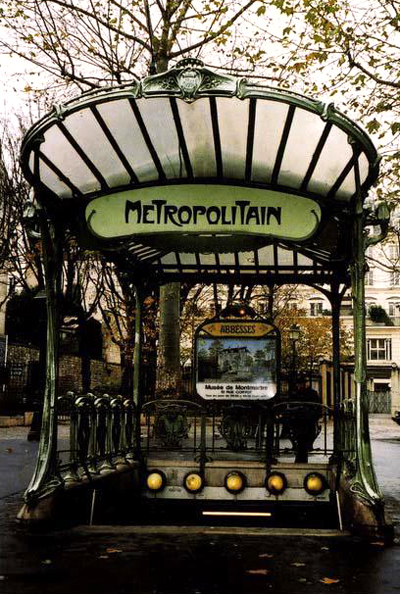
Metro station "Abese", Paris; Hector Guimard. 1900
A fundamental influence on the development of modernity was the opinion that design can serve as a tool for changing the social order. Liberation from ornamentation became the main postulate of constructivism and futurism. The desire for functionality and the use of new materials and technologies has influenced the development of modernity, covering all areas of design - from interior and furniture to ceramics, graphics and architecture.
The adherents of Art Nouveau embodied their ideas about the modern in works using newly-invented materials and technologies, in objects with simple shapes, with minimal surface modeling, without excessive decorativeness and with vast empty spaces.
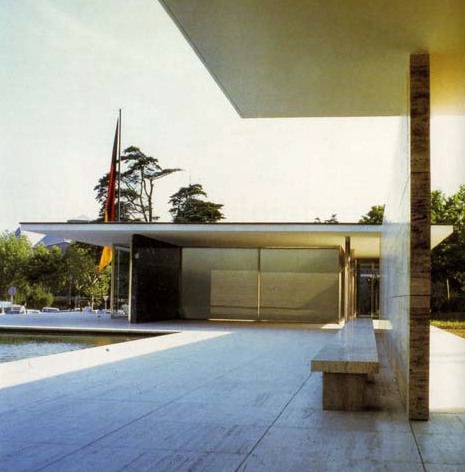
German Pavilion, International Exhibition, Barcelona. Ludwig Mies van der Rohe. 1949 g.
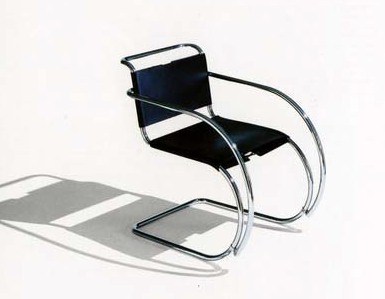
Armchair with armrests. Ludwig Mies van der Rohe. 1947 g.
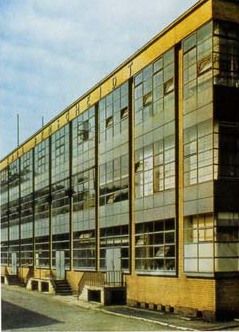
Fagus Shoe Factory. Walter Gropius and Adolph Meyer.
The Bose Art style originated in the second half of the 19th century at the Paris School of Fine Arts. This style is characterized by dimensionality, symmetry, solemnity, majesty and exquisite ornamentation. It combines the traditions of ancient Greek and Roman architecture with the traditions of the Renaissance. It is an eclectic neoclassical style characterized by the use of paired columns, in-pattern patterns, high parapets, domes, protruding facades, balustrades, pilasters and pavilions.
By the 1920s. the style lost its popularity, it was considered too pompous. Only at the end of the 20th century, some elements of the Bose art style were revived in postmodernism.
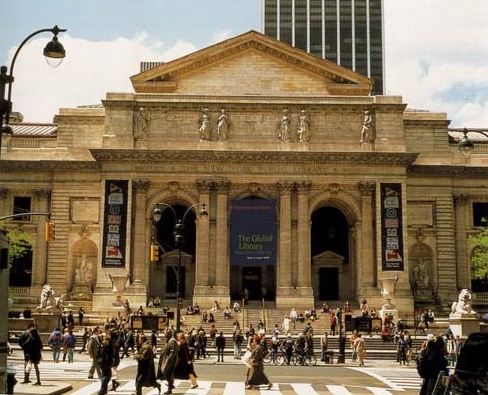
Detail of the facade of the New York Public Library. John Carrere and Thomas Hastings. 1911 g.
Jugendstil.
Art Nouveau is the German and Scandinavian variety of Art Nouveau that prevailed in the art of the 1980s.
Art Nouveau designers and architects saw the use of natural forms as a way of reforming design and society. Traditional ethnic motives were used in interiors and architecture, the works were distinguished by simplicity of forms and modernity. In continental Europe, Art Nouveau spread later than Art Nouveau, as many German designers and architects were still passionate about the revival of Classicism. But by the 1890s. they were ready to embrace fresh alternatives to historical styles.
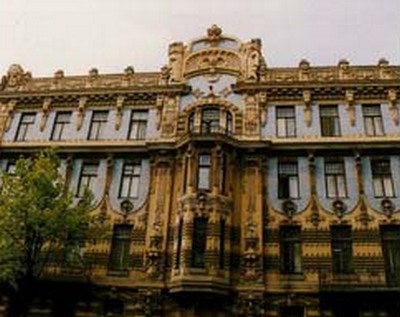
Facade of the residence. Latvia. Riga.
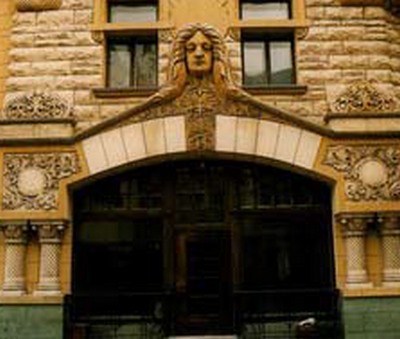
Latvia. Riga. st. Joniel 73-79. Wilhelm Boxlaff. 1903 g.
Until 1925, this style was also known as the Art Nouveau style. Art Deco - international style
originated in France in the 1920s. where he focused primarily on the luxury goods market.
In the USA, the Art Deco style was characterized by luxury, a flight of imagination, a desire to escape from reality. Egyptian and Aztec motifs dominated American architecture in the early 1930s. Classic
Chrysler Building is considered an example of Art Deco architecture.
In Britain, the Art Deco style is reflected in the lavish, flashy interiors of London's many cinemas.
The main features of the Art Deco style are geometric, stepped shapes with clear edges and rounded corners, bright colors.
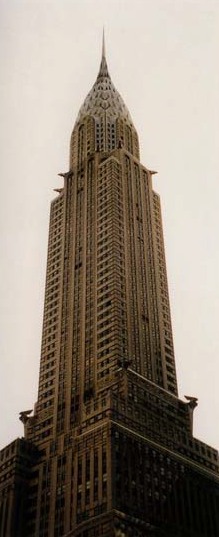
Chrysler Building, New York; William van Alen. 1930 g.
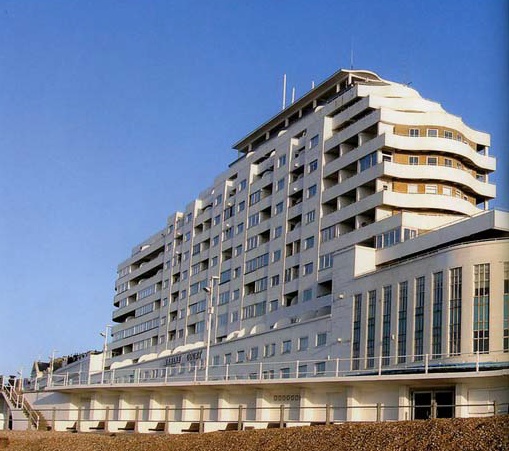
Maritime Administration, Hastings, UK; K. Dalgleich, R.K. Pudden. 1959 g.
The influence of Art Nouveau on the development of Art Nouveau was especially noticeable in Prague, where a group of architects and designers, inspired by the sculpture and painting of the Cubists, she formed an important, albeit short-lived movement called Czech Cubism. Broken dots, broken flat surfaces and crystal motifs were the hallmarks of this unique avant-garde style. The style did not exist for long, but it had a great influence on the further development of art.
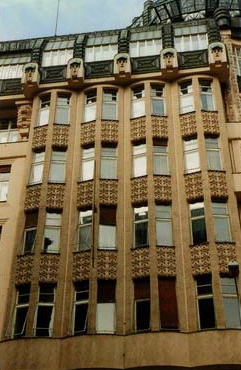
Cubic building. Prague. Czech.
The Bauhaus style (another version is "Bauhaus") is the direction of modernist architecture that prevailed in the 1930-1960s. Initially, it originated in Germany, but soon became widespread throughout the world. Its founders were Walter Gropius, Peter Behrens and Hans Hopp, among the most famous representatives are Le Corbusier (France), Mies van der Rohe (Germany, USA), Jacobus Aud (Netherlands) and some others.
The Bauhaus credo was that the results of the work of artists, artisans and technologists at the same time were to be embodied in one object.
The closest to the Bauhaus movement can be considered the ideas of rationalism, constructivism and, of course, modernity, which actually became the source of the main ideas. 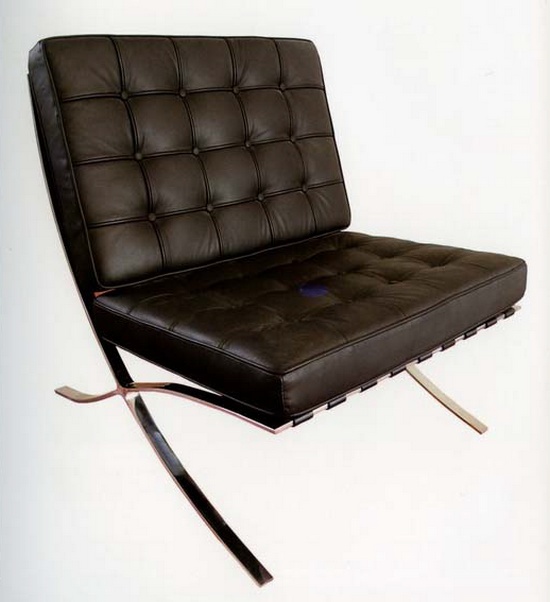
Armchair "Barcelona". Ludwig Mies van der Rohe.
The main features of the style are the rejection of ornamentation in favor of functionality, the predominance of asymmetry.
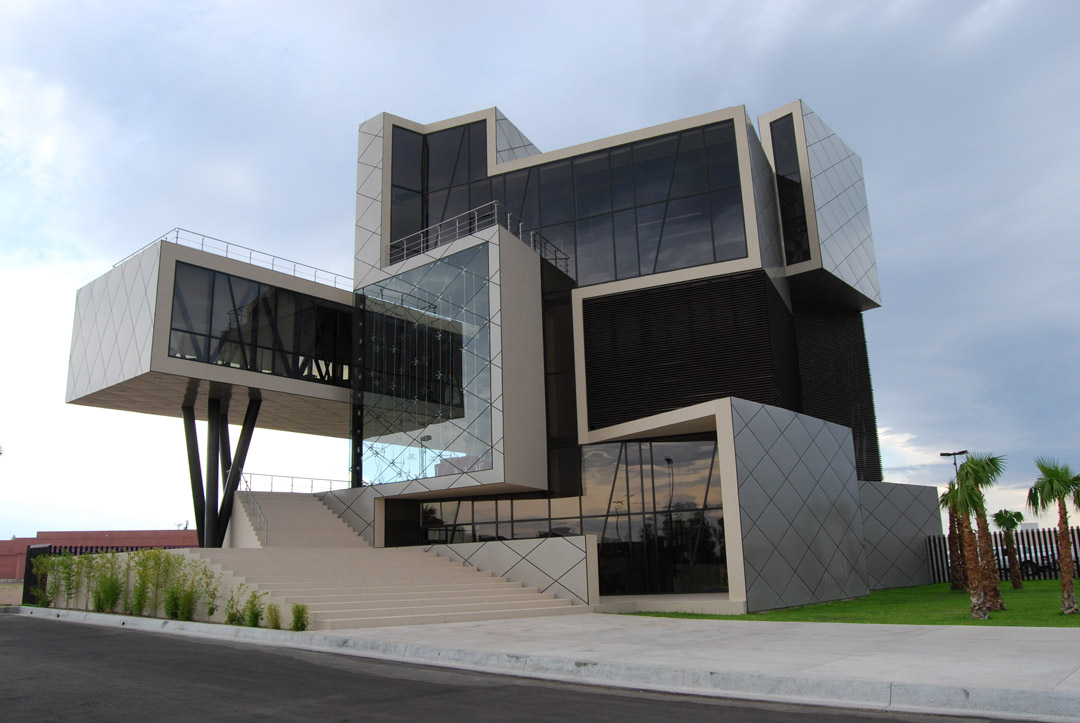
Rationalism.
The Italian style of rationalism was founded in 1926 in Milan by a group of seven architecture students, believed that in Europe there is a new, fresh artistic spirit, and Italy's duty is to develop it. Rationalism primarily affected architecture - it was distinguished by a logical, functional approach and a rejection of excessive ornamentation. The movement successfully began its existence and immediately attracted the attention of the public. Unlike futurism, rationalism glorified technical progress, using new materials: for example, chrome-plated metal parts of rigid geometric shapes.
The residential complex Palazzo Giuliano, built in 1929 by architects Giuseppe Pagano and Gino Levi-Montalcini, can be considered a vivid example of this style. Its facade was originally painted yellow and green colors - this is how the illusion was created that the building consists of separate floors stacked on top of each other. For the first time, such a unique architectural element as panoramic windows was used in it.
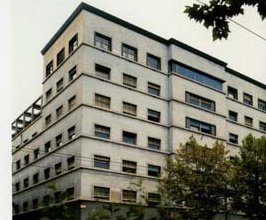
Palazzo Giuliano, Turin, Italy: Giuseppe Pagano and Gino Levi-Montalcini. 1979 year
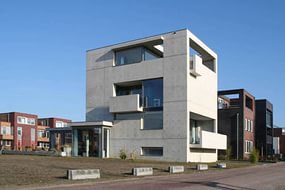
Meyer's house in Almelo.
Surrealism.
The term was coined by the poet Guillaume Apollinaire (1880-1918).
Surrealism is a trend in the art of the twentieth century, which arose on the nihilistic ideals of Dadaism, which has replaced. It developed under the influence of the ideas of Sigmund Freud (1836-1939), the creator of psychoanalysis, and was led by the French poet André Breton. The followers of this movement believed that the subconscious should be expressed in visual or poetic images. The paintings of Salvador Dali are a good example of this. And his designs, such as the lip-shaped sofa, created new ideas about what art and design should be, often blurring the lines between them.
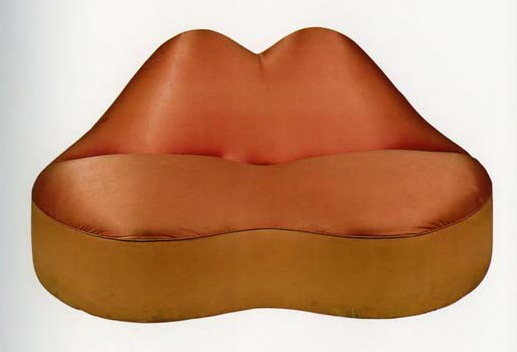
Sofa lips; Salvador Dali. 1937 g.
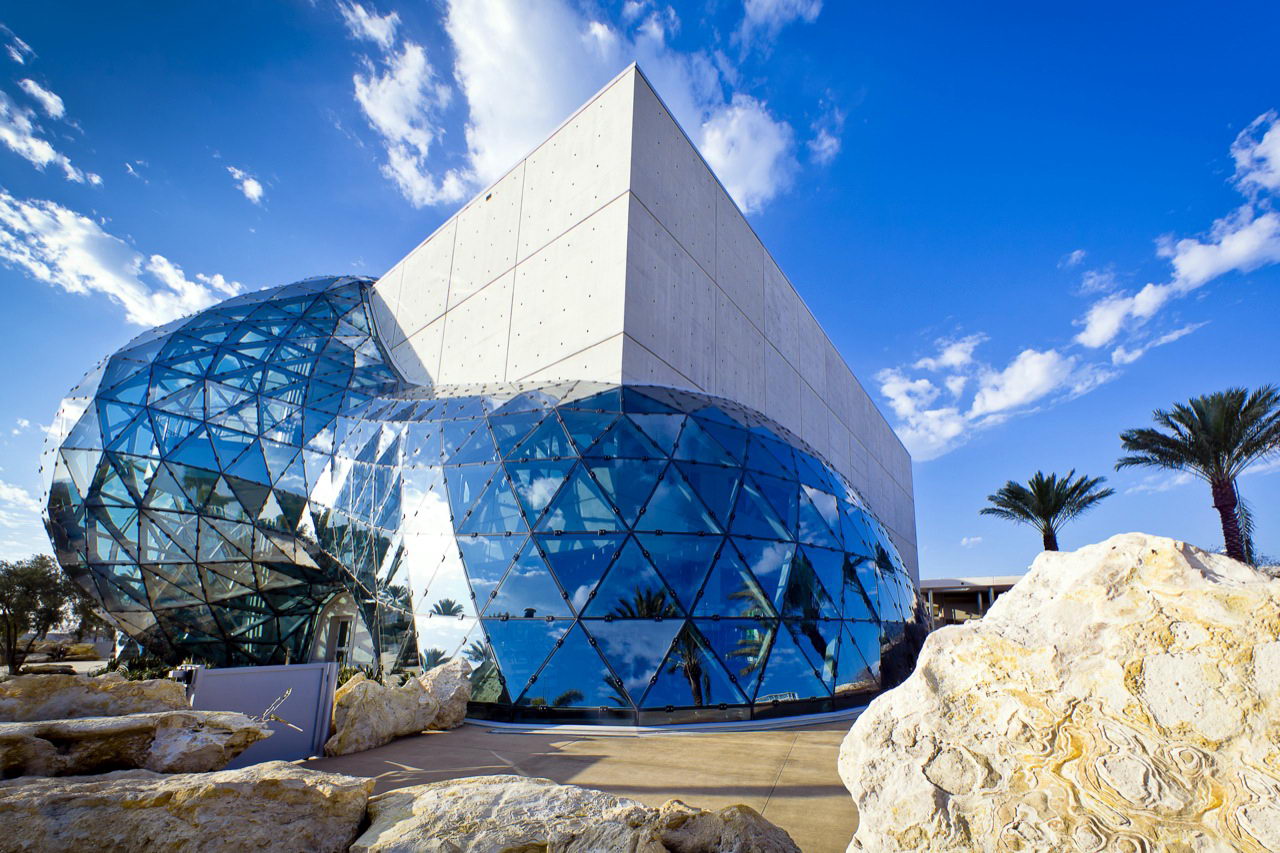
A project from the future.
Organic design.
Organic design is based on the concept of organic architecture pioneered by Frank Lloyd Wright and Charles Rennie McIntosh in the late 19th century. Her main postulate was that individual elements, such as pieces of furniture, should visually and functionally fit into both the interior and the overall concept of the building. Moreover, in their opinion, the building itself should also be related to the terrain, where it is located through structure, materials or colors.
Despite the fact that the concepts of integration and naturalness were initially laid down in this approach, they were not necessarily expressed in the appearance of objects, and organic forms did not immediately become its central theme. However, organic functional forms gradually took over design. We can observe their smooth, ergonomic lines in design today.
New technologies and materials, especially plastics, and the possibilities of computer design have all contributed to the evolution of this style.

Sydney Opera House: Jörg Utzon. 1958-1973
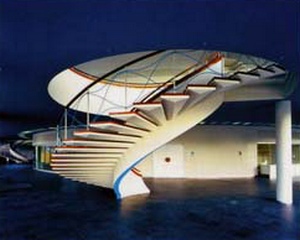
Stairs at the Berlin Congress Center: Hermann Henselmann 1979
International style.
When the Bauhaus school was closed in 1933, Walter Gropius, Ludwig Miss van der Rohe and many other Bauhaus teachers emigrated to the United States, where they continued to spread the philosophy of their movement.
The international style is one of the main trends in modernist architecture during the 30s - 60s of the twentieth century. Its founders were mainly former adherents of constructivism, architects: Peter Hopp, Peter Behrens and Walter Gropius, Miss van der Rohe, Jacobus Aud, Le Corbusier.
The characteristic features of the international style are the rejection of all types of historical decor and national cultural characteristics, the use of pure geometric shapes and lines, smooth and light surfaces of metal and glass. In the construction of buildings within the framework of this architectural direction, reinforced concrete was widely used; in the interiors of buildings, great attention was paid to the creation of wide open spaces.
After the end of World War II, skyscrapers designed by Philip Johnson, Bey Yumin and Miss van der Rohe became the embodiment of the ideas of the international style. The French architect Le Corbzier gradually moved away from internationalism towards brutalism. Gradually, this trend in architecture penetrated into architecturally conservative countries, for example, Brazil and Italy.
In the 50s of the 20th century, the crisis of the international style began. In the 1970s, he was criticized for being ordinary and narrow-minded by the founder of postmodernism, Robert Venturi.
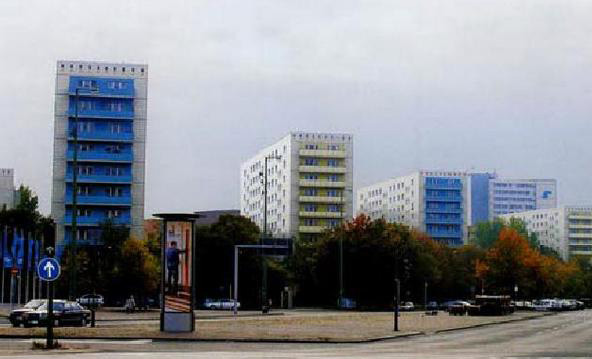
Berlin buildings in an international style.
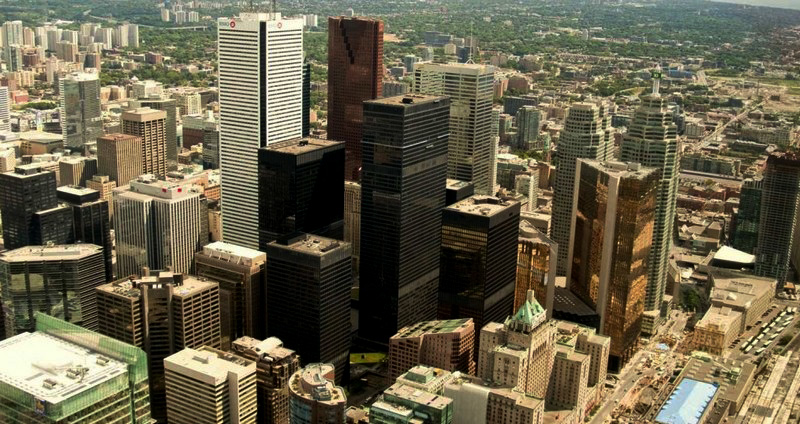
Most of New York's skyscrapers are also in an international style.
Biomorphism.
Also known as neo-organic style. Biomorphism is characterized by the use of natural forms. This style, making extensive use of natural outlines, curl motifs and elongated plant forms, first appeared in the early 20th century and was embodied in the work of many Art Nouveau designers. However, it became possible to truly appreciate its merits with the invention of new technologies and materials, in particular plastic.
30 Mary Ax Tower in London, better known as the Gherkin or Gherkin, is one of the most prominent buildings in the capital of Great Britain, a skyscraper that is strikingly different from other buildings in London. IN english language the building is named ‘Gherkin’, which literally translates as “pickled cucumber” or “gherkin”. The cucumber in London is one of several modern buildingsthat were erected in last years in the historic part of London.
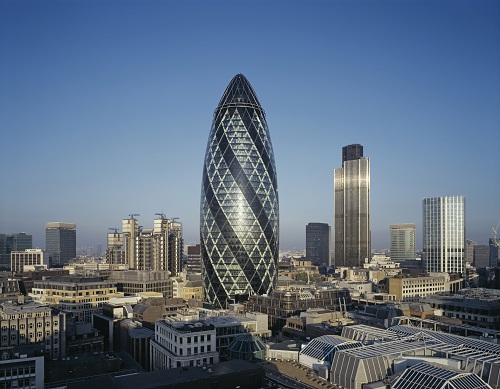
St Mary Ax. "Gherkin": Foster and Partners. London 1997-2004.
The Turning Torso building in Malmö, Sweden can also be considered a biomorphic style. The skyscraper resembles a fragment of a DNA molecule. The Turning Torso building was designed by Spanish architect Santiago Calatrava and officially opened on August 27, 2005. The 54-storey tower is 190 meters high. Upon completion, the building became the tallest in Scandinavia, the tallest residential building in the EU and the second tallest residential building in Europe, after Moscow's 264-meter Triumph Palace.
The design of the tower is based on a sculpture by Santiago Calatrava called “Twisting Torso”. It consists of nine segments - five-story pentagons that “rotate” as they rise; the uppermost segment is “rotated” 90 degrees clockwise from the first floor.
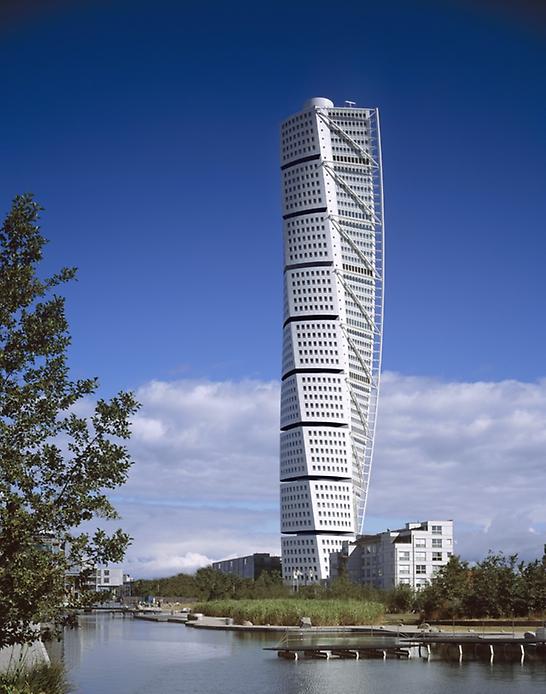
Turning Torso. Santiago Calatrava. Malmo, Sweden 1999-2005.
An abbreviated version of the phrase "popular art". This style originated in the United States and Great Britain as a reaction to abstract painting, which was considered too complex and elitist by the supporters of Pop Art. They gave preference to objects from everyday life. An example of this is the comics of Roy Lichtenstein, where the faces of the characters resemble cartoon characters, painted in bright, fluorescent colors. For pop art, it was typical to use serigraphy (easel screen printing) - a technique for mass printing.
Influenced by popular culture, supporters of this style openly disputed the principles of "good design", denying modernity and its values \u200b\u200band replacing them with their own - variety, fun, rebellion. Pop art quickly took over the media and advertising. A good example of this is the cover of the 1967 disc of the Beatles, Sergeant Pepper.
In architecture, the manifestation of the pop art style was reduced to small architectural forms, the largest of which resulted in the construction of pavilions of diners in the form of giant hamburgers. Pop art was much more widespread in urban sculpture. An example is a bench on one of the streets of Kazan. The aesthetic side of the bench is questionable (legs with pants down ...), but an example of pure street pop art is there.
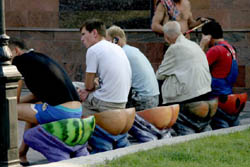
Bench in Kazan. The designer is unknown.
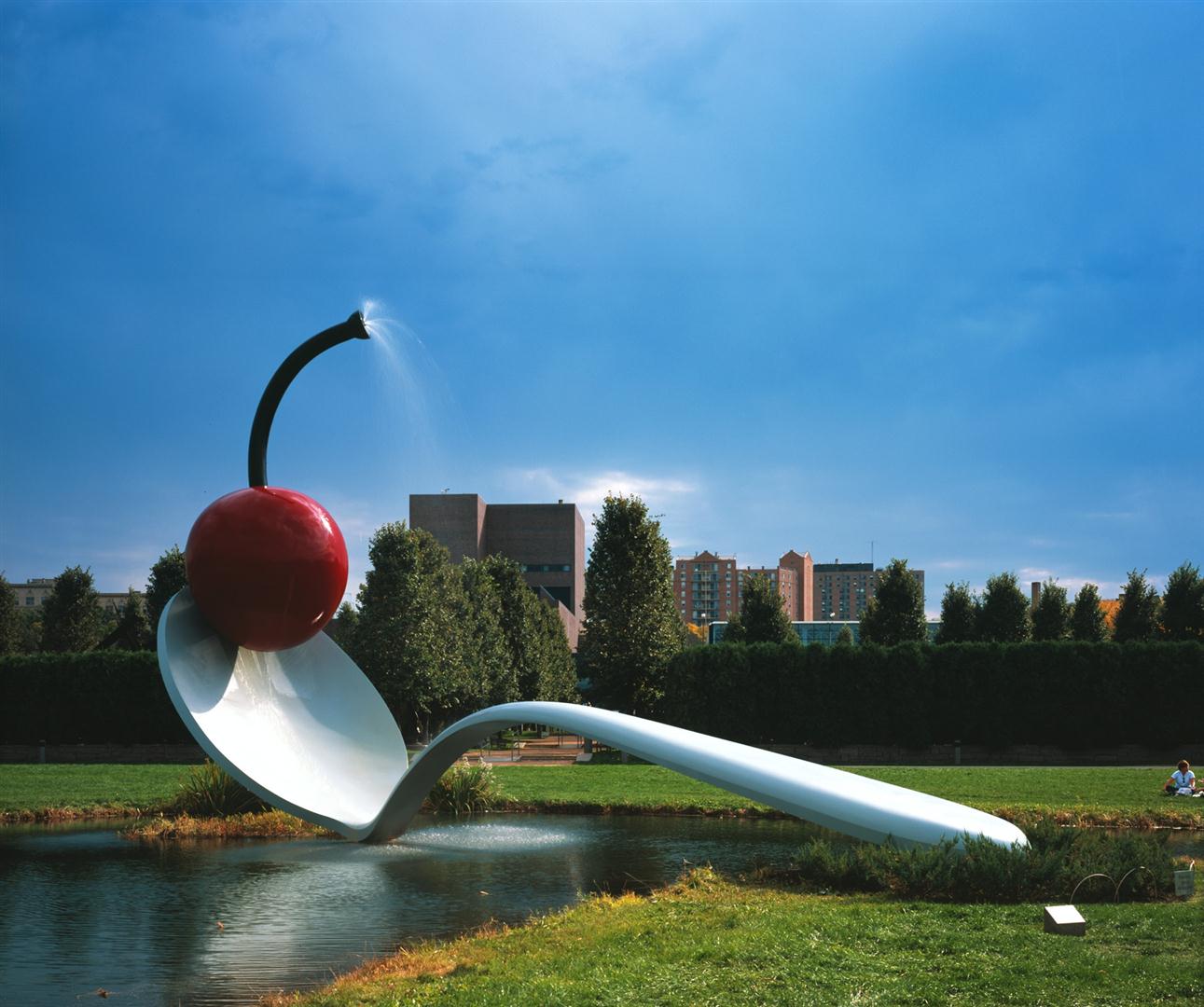
Another example of pop art style in small architectural forms.
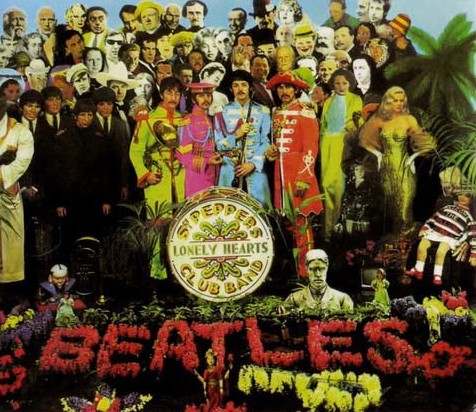
ABOUT cover of the 1967 Beatles disc. Peter Blake and Jann Howorts.
Minimalism.
The term "minimalism" first appeared in the mid-1960s and was used to refer to the sculptural work of Robert Morris, Dan Flavin, Donald Judd, and several other artists. Today, the term is used in a wide variety of fields, from fashion and music to design and architecture.
In architecture, minimalism is expressed in the reduction of expressive means, in the wide use of empty spaces, in absolute simplicity and purity of lines. The work of John Pawson is a good example of this. His architectural concepts are based on the properties of space, light and materials, he rejects the mannerism in the style of objects.
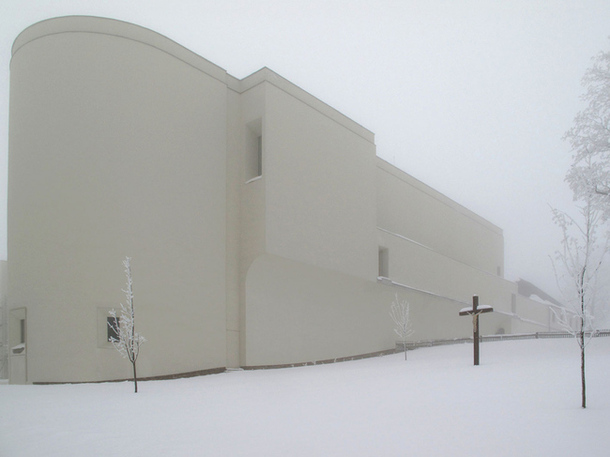
Apse of the church of the Cistercian monastery in Novy Dvor. John Pawson.
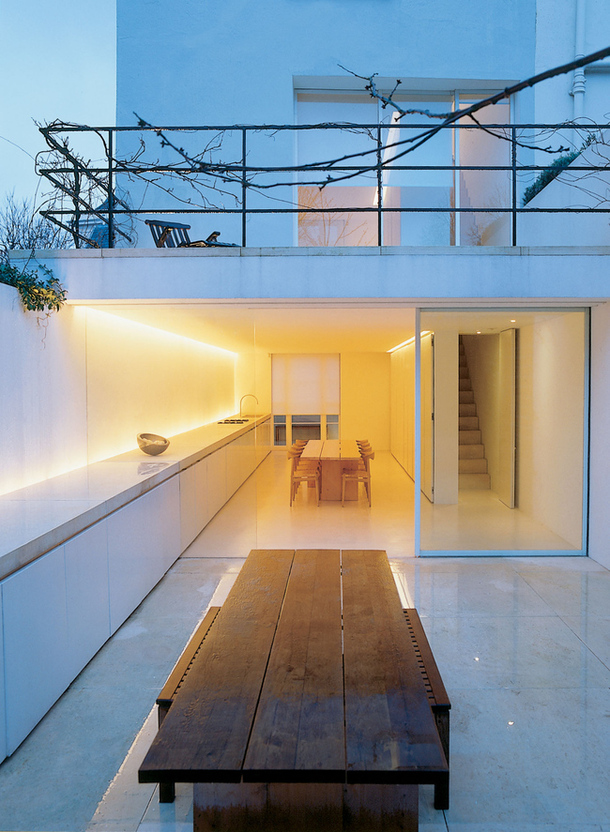
Home of John Pawson and his wife Katherine (1999).
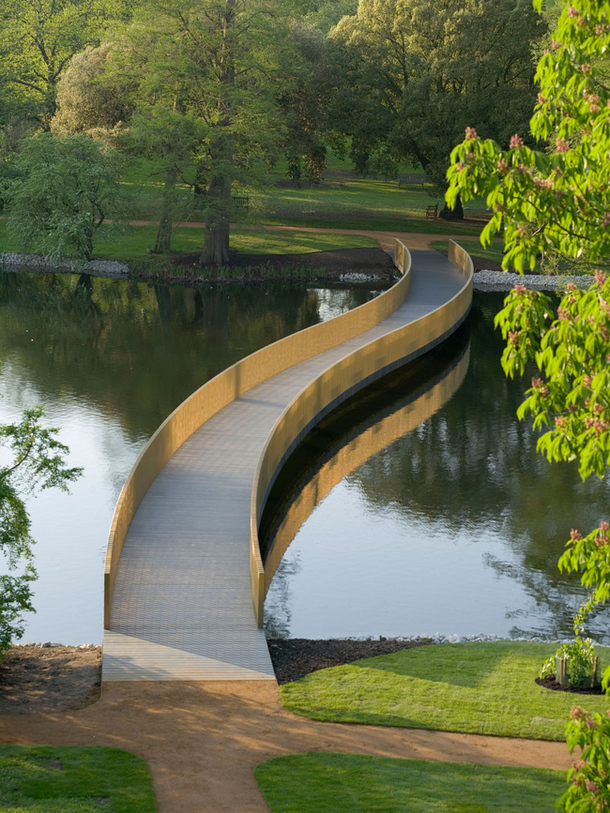
Pawson's 2006 footbridge at Kew Botanic Gardens in London.
High-tech is a style in design that partly borrowed the expressive means of postmodernism, especially in architecture, and emerged in the early 1970s. This style is characterized by external simplicity and elegance, as well as the use of industrial materials or materials made with the latest technology in a new context.
High-tech pioneers were British architects such as Norman Foster and Richard Rogers, who incorporated industrial elements into their buildings. Following LG Sullivan's motto "form follows function", they transformed structural elements into design elements.
A classic example of high-tech architecture is the Georges Pompidou Center in Paris, built by Richard Rogers and Renzo Piano (1971-1977).
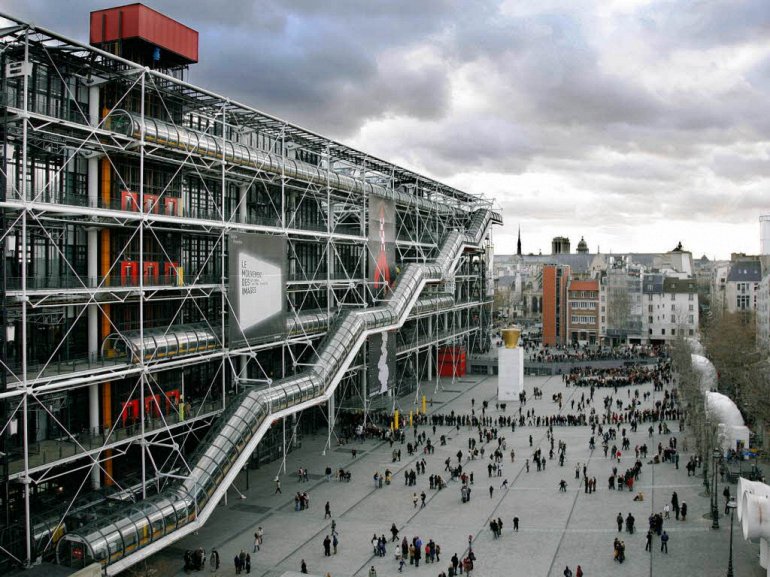
Center Georges Pompidou in Paris. Richard Rogers and Renzo Piano (1971-1977).
Working on the project for the Georges Pompidou Center, Rogers and Renzo decided to place all communications outside the glass façade, turning them into design elements, so that stairs, cables and steel frames were on public display.
Nowadays, this style is usually used in combination with more traditional design elements.
![]()
High-tech house P048 in Australia.
Postmodernism.
Postmodernism is a trend in art that arose as a reaction to the design rationalism of modernity. Its origins began in the 1960s, and it was finally formed in the early 1980s.
Postmodernists believed that all the achievements of modernity are a few unreadable books and incomprehensible objects, soulless works of art and buildings in which people do not want to live.
In one of his books, Robert Venturi questions the emphasis on logic, simplicity and order inherent in modernity, and argues that ambiguity and contradiction also deserve a place in art.
Postmodernists advocated a fusion of fine arts and popular culture, elite and popular art.
The anti-rationalist approach reigned in design in the decadent 1980s, many trends emerged within it, including deconstructivism, hi-tech and post-industrialism. However, by the early 1990s, at a time of economic downturn, designers were once again turning their eyes to a more rational approach.
An example of postmodernism is the Marriott Hotel in San Francisco.
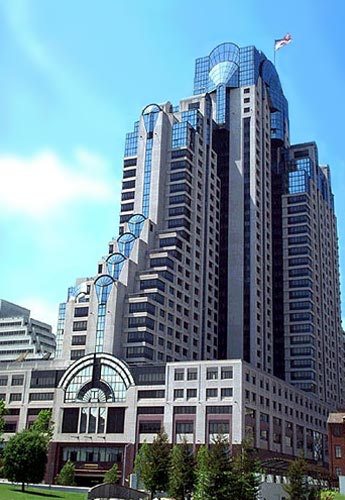
ABOUT tel "Marriott". San Francisco.
Another example of a postmodern interpretation of the forms and images of the architecture of the past is the building of a communications center in Canada.

Communication center building. Canada. Toronto.
Another example, but from the 21st century.
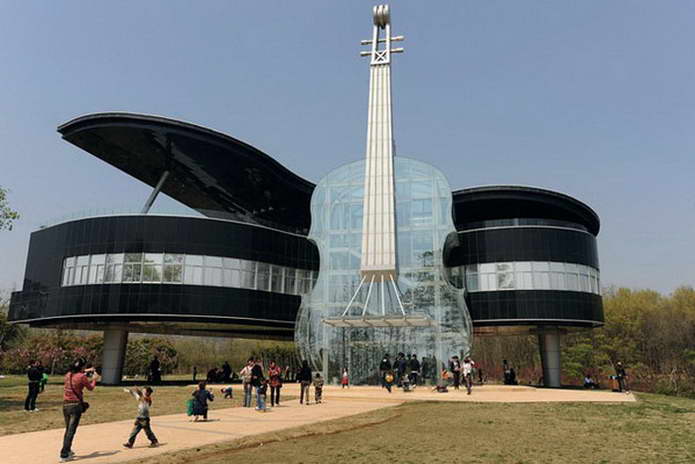
House Royal with Violin, China. 2007 year
Deconstructivism.
The deconstructivist style that emerged in the 1980s was not so much about design in general as about architecture and interior design. This style is characterized by broken shapes and overlapping surfaces - in contrast to the logic and order inherent in Art Nouveau. The concept of deconstructivism was proposed by the literary critic Jacques Derrida in the late 1960s. Derrida believed that every text can be interpreted in many different ways, so it never means exactly what it says, and what is written does not convey exactly its meaning. Such "gibberish" could only be invented by a critic. But in the late 1970s, Derrida's theory found application in one of the styles in architecture and interior design - deconstructivism, whose goal was to demonstrate the internal content and functions of objects.

Jewish Museum in Berlin. Daniel Libskind. 1998-2003
![]()
Central Library in Seattle
The Memphis Group was the name given to the collective of furniture and industrial product designers who played a leading role in the design of the early 1980s. and worked in Milan. The debut of the group, led by Ettore Sottsass, took place at the Milan Mbela Fair in 1981, and was a shock to the design community, who first saw laminated plastic furniture in bright colors with leopard-like patterns or geometric kitsch designs.
The band's name comes from the title of Bob Dylan's song "Stuck Inside of Mobile with the Memphis Blues Again".
The Memphis style was anarchic and pursued mainly the goals of the designer's free expression. Following one of the basic postulates of postmodernism, he actively opposed himself to the "good taste" promoted by the styles of the modernist trend.
Experimenting with materials, shapes and colors, designers created high-quality and functional items that are in demand by the consumer. This style is characterized by catchy geometric shapes, bright colors, the use of high-tech materials (for example, laminated plastic), as well as direct citation of elements of historical and avant-garde styles.
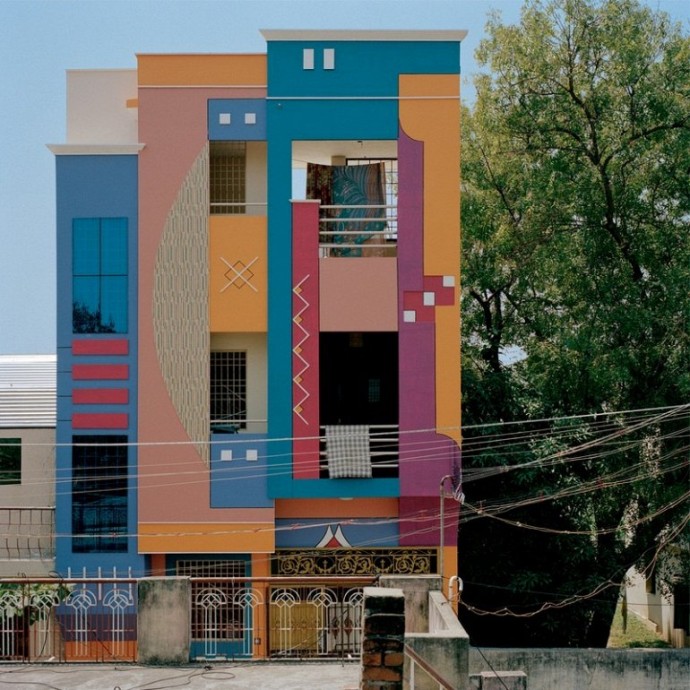
Memphis style house in South India.
Like many well-forgotten old things, Memphis-style design is experiencing a new wave of popularity. As at the beginning of its history, today it is distinguished by revolutionary courage and creativity. And even though now it is no longer an innovation, it remains recognizable and atmospheric. It is worth seeing just one example of a Memphis-style interior and it immediately becomes clear that the main sources of inspiration are kitsch, art deco and pop art. By the way, there is a clear similarity with the latter: the same rejection of conventions, the same brightness and spectacular forms.
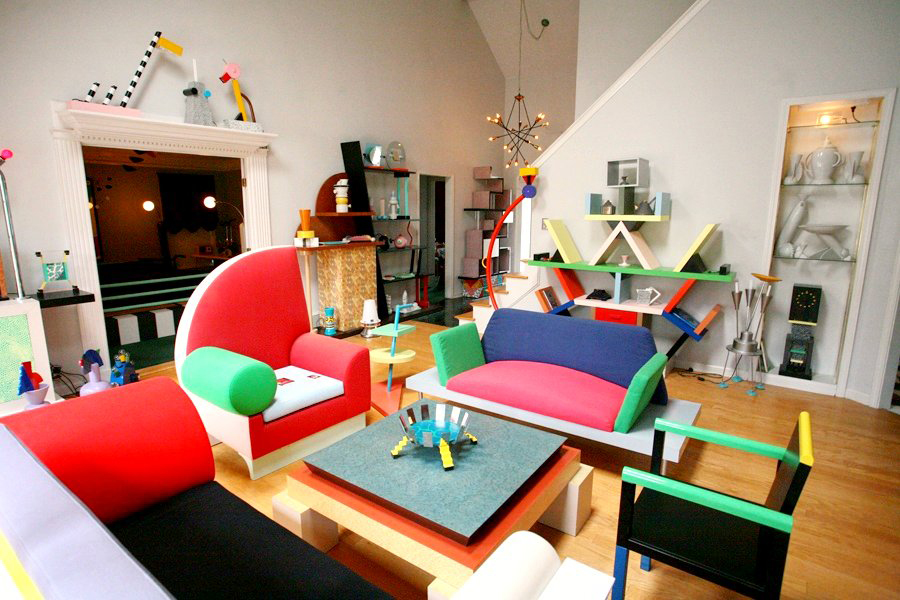
Memphis-style interior
On the Memphis style, I think to finish my article "Styles and trends in modern architecture and design. "Even if I did not touch on the newest directions in the development of this topic, but the review in my opinion turned out to be quite good. All comments are accepted and welcomed. The article will be edited.
Speaking about styles in architecture and interior, I would like to say that at the moment we practically do not use pure styles, since times and tastes change very quickly and more and more attention is paid to the individuality of this or that building or the reflection of the owner's personality in the interior. And if earlier the external appearance, the style in which it was built, corresponded to the era and fashion, then today the interior lives a separate life and is not always guessed by the facade of the building. However, it is worth noting that it is very important to maintain harmony and continuity of both generations and styles, so that the use of these styles is appropriate. It is this work that a professional designer must do, feeling the potential of the room and revealing it to the maximum.
Antiquity
Antiquity as a historical style means architecture and art Ancient Greece and Rome. Since in these cultures the gods who governed life were of prime importance, temples became the most significant and great buildings. In the era of Ancient Greece, important architectural techniques, structures of bearing columns with entablatures, architectural breaks, orders of columns were laid. Doric and Ionic orders personified masculine and feminine principles.
Later, Corinthian columns appeared with the use of plant motifs. The arrangement of stadiums and theaters, triumphal arches, cylindrical vaults, caryatids, supporting cornices, we inherited from these great cultures. A sculpture with perfect proportions, realistic and perfect at the same time. Subsequent eras and their inherent styles, Renaissance and Classicism, apply and develop elements laid down by these great cultures. Arrangement of a pitchfork with a patio, frescoes, painted wine and oil jugs.
Gothic

Gothic refers to the art of the Middle Ages between the second half of the 12th and early 16th centuries. Gothic art did not develop uniformly in different countries, somewhere the Renaissance was already flourishing, and in other countries it was still built in the Gothic style. The main element in Gothic architecture is the structural skeleton of the building, which allows the construction and erection of floors in tall and wide buildings without the need to reinforce load-bearing walls... The interior space becomes like a glass lantern with beautiful bright stained-glass windows, pointed arches, towers, domed ceilings, galleries, tapestries, carved furniture, reflecting architectural elements in miniature.
Mannerism

The transition of culture from the Renaissance to the Baroque. XVI century. This style represents a transition from monumental heavy classical forms of the Renaissance to a style lighter, more graceful, rich and lush. A style that has collected the best achievements of the past years and presented them in a new "mannered" manner.
Curious examples of Mannerist architecture can be found in the Netherlands, Germany, where there was no such strong influence of the classics.
Baroque
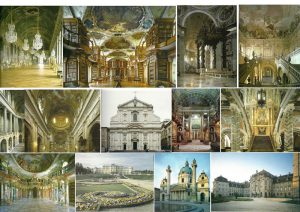
Baroque art stood at the service of both religious and secular authority. Pretentious and smart, it had to impress and convince. A pretentious luxury style, the name of which comes from the name of an irregular sea shell.
The style was reflected in architecture, sculpture, literature, music and dance, in short, on the way of life, which spanned the period from 1600 to 1750. Pretty overwhelmed style. An abundance of decorative elements, ornaments, a lot of artificial, pretentious, not natural are used. Interest in science is shown. In this era, the Versailles Park is planned with mathematically lined avenues and geometrically trimmed trees.
The interiors are replete with sculpture, characteristic elements, expanded columns and currencies, rusticated columns and pilasters. A lot of bright painting is used, the ceiling and walls were painted. Contrast was often used, for example, the marble flooring mirrored the checkerboard pattern. A lot of gilding is used. Exquisite sophisticated furniture upholstered in expensive fabrics. Wide four-poster beds. The mirrors are framed in gilded frames with stucco moldings that reproduce floral designs. This style requires space so that decorative elements do not suffocate from their own saturation.
Rococo

This style is the development of the Baroque style. Mid-18th century. This is the style of eternal youth, spring, carelessness, bliss and erotic fantasies. There is even greater refinement in comparison with the Baroque, Illinia, geometric. The interiors are very light, there is a floral ornament everywhere. A lot of accessories appear, cutlery becomes more diverse, and many intricate gizmos appear for every function.
The cult of exquisite delight. The furniture shows graceful carved legs, curved lines. Small console tables, chests of drawers, bureaus, secretaires, wardrobes abound. Typical armchairs - "Marquise" and "Bergère". Colors, pale blue, pink, pale yellow, gray blue, white, gilding.
Classicism
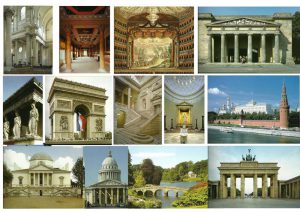
This is a style that brings us back to the aesthetic ideals of Ancient Greece and Rome. XVII-XIX centuries. The main principle is rationalism and adherence to strict canons. Regular layout, clarity of shapes, geometry, symmetry of objects. Nevertheless, in interiors this is by no means a limited style, but, on the contrary, is not inferior in its wealth to either the Baroque or Rococo.
High quality materials are used for floor and wall cladding, marble, natural expensive varieties of wood, silk. There are many attributes of military glory in stucco molding, the repetition of Greek and ancient Roman ornaments, columns, half-columns, furniture repeating objects from ancient Greek frescoes and amphora paintings. In the construction of manor houses, gazebos with colonnades, nude sculptures, steles are used, demonstrating calm, cold prudence, turned to eternity, greatness.
Modern
A style born in Europe at the end of the 19th century. It also bears different names according to the countries where it prevailed: Art Nouveau (Belgium and France), Modern Style (England), Sezession (Austria), Jugendstil (Germany and Northern Europe), Liberty (United States), Floreale ( Italy), Modernismo (Spain and Latin America).
The main features of this style are vegetative, rounded shapes, twisting in the middle. Asymmetrical curved lines in both architecture and decoration.
In this style, there is a continuity from Japanese prints, which are also characterized by a fascination with rounded shapes. This is a bourgeois style, very expensive, implying the execution of many things to order, where it is required to fit the form into the interior conditions. Favorite colors are pastels, various shades of green, brown din, all natural colors that can be found in the surrounding nature. Custom-made furniture, twisted, fancifully curving stairs, intricate lamps, stained glass windows with stylized patterns, the frequent presence of female images in graphics and paintings. There are many beautiful buildings, examples of their era and this style: the Solvay Hotel in Brussels, the Tassel Hotel, the Glasgow School of Art, the Grand Market building in Frankfurt, the Batllo house in Barcelona, \u200b\u200bthe Metropol Hotel in Moscow and many others.
Art Deco
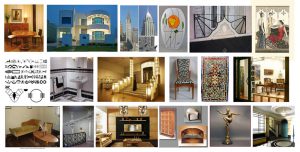
A movement whose era lasted mainly from 1920 to 1939. This style, like other historical styles, has taken a place in architecture, interior design, graphic design, industrial, fashion, painting, sculpture, printmaking and cinema. The Art Deco style combines various styles of that era and is influenced by other styles existing in that era, such as Constructivism, Cubism, Futurism. On the other hand, the treasures of Egypt are being discovered, which also affected the art deco, on colors, lines, ornament and graphic techniques. The discoveries and developments of that time also affected the lines, the influence of aviation, electric lighting, radio, skyscrapers, submarines.
In architecture, this influence takes the form of glass structures, angles arranged in a symmetrical shape. The furniture is decorated with zigzags, triangles, round shapes, the image of the sun. Favorite art deco materials, aluminum, stainless steel, varnish, shark skin, zebra skin. The color scheme abounds in shades of brown, ivory, gold and bronze. Unlike Art Nouveau, this style gravitates towards urbanism, technical progress. Elegant and functional, this style was in keeping with the spirit of the times.
Minimalism
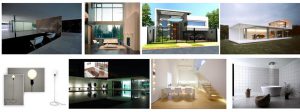
This style appeared after the Second World War and offers simplification as an interior solution. Minimalism means beauty and harmony with minimal expression.
The spaces are predominantly spacious, filled with light (daylight is very important), as a rule, they have basic neutral light colors. Minimum finishing material and techniques, rather the ideal surface of the material itself is emphasized, as a sign of quality. Furniture is also strictly in minimal quantities; it either participates in the formation of space, dividing it into zones, or adjoins the walls, leaving a maximum of air. The sofas are wide and low, low pedestals, walls that do not require hanging anything. There is no textile, and if it is, then because it is required by the function of the object (sofas and armchairs). The main line of the style - the less the better. Plants are used as a little variety of the interior, they are welcome and large-format paintings, which are preferable to put on the floor, rather than hang, and lean against the wall. This style suits people who are prone to perfect order.
Constructivism
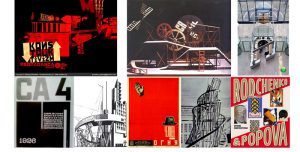
A style that was born in Russia in 1914 and took the forefront after the Great October Revolution.
Style that reflects proletarian culture, the ideals of modern times, functionality. New ideals opposed to the outgoing era of decadence. There is no lyricism, no romance, these are objects inspired by the technical process, inspired by new possibilities that were still to be discovered then.
Manufacturing art. Architecture, industrial design, interior design, propaganda posters mainly use simple geometric shapes that are combined with each other depending on the function of the concept. Colors: black, red, white, gray, blue and yellow. In interiors, fuzzy zoning, straight lines, geometry, square, rectangle, triangle, circle are used. Today, constructivism is actively used by Scandinavian designers and architects.
High tech

In the early 70s of the 20th century, a revolution took place in architecture, which marked the end of the influence of modern classics. With the acceleration of technological progress, architects are beginning to experiment with new materials and new structural forms. The inner structure is now facing outward. The first building to embody the ideals of the new style is the Pampidou Center in Paris. Technical communications are open to the outside and become part of the aesthetics and decorative solution of the building.
Heating pipes, ventilation, stairs, elevators, all this is not hidden, but on the contrary is demonstrated. The same thing happens in the interior. New materials, metal, glass, reinforced concrete, bright color, an abundance of metal tubes, where the viewer is lost, what is it really unclosed communications, a structural element, or decorative. With the development of new spaces previously intended for factory production, and their transformation into clubs, studios, shops, it begins to dictate a new aesthetics in the interior. The room seems to be working, where all these communications and pipes are an integral part of what the room lives, fasteners, stands, legs, furniture handles are especially emphasized, made in chrome with accented nodes, they explain to us the technical arrangement of objects. Often, flirting with this style, designers apply it in places where it would seem that such a number of tubes, screws, and other technical elements should not be used. It is important to understand the relevance of this style here.
Eclecticism
This is perhaps the most commonly used style today. Eclecticism takes everything existing styles, but mixes something of their own. Interiors with eclectic style are individual, spontaneous and depend on the taste of the designer or decorator. It can be a mixture of several, usually no more than 3, styles, where antiques reflecting their era can stand with modern Vitra chairs. This style should not be confused with Kitsch, since the main thing here is the harmony of the combination and the individual solution and the transfer of the author's mood and character. This is not a new style, in a certain form, eclecticism has always been needed and at the everyday level it combined the continuity of generations and the coexistence of the old with the new.
Kitsch
Kitsch is more than a decorative style. It is the fruit of an age of consumption, non-functional and enjoying the joy of displaying the items themselves. Kitsch is a democratic style that allows you to arrange objects using elements that you like without worrying about inner harmony. As a typical attribute, one can imagine a collection of numerous figurines, memories of something, dolls and other unnecessary and non-decorative things that are carefully displayed in a prominent place and, as a result, play a role in the decoration of the room. Extravagance, multicolor, not following fashion, but existence according to its internal mechanisms. Exaggeration of objects and their execution in a deliberately large format are often used. The combination of the incompatible, love for retro accessories.
Country
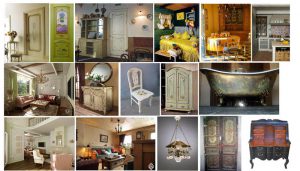
The style, the name of which takes us back to the North American province, to the homesteads, villages, the decor of which implies certain decisions and preferences. Country, country style, this is a departure from industrialism into the eternal values \u200b\u200bof rural life. This style has different interpretations depending on the color of which country it reproduces. This is both French Provence and German shaby style. The main distinguishing features of this style are the emphasized simple furnishings, only natural materials, national flavor, a lot of textiles, covers on sofas and sometimes on chairs. It can be a mixture of old things, as if inherited from previous generations, with new ones, but in the same style. Facing ceramics, as a rule, have floral motifs, or they can be tiles. Just as often, objects appear to be frayed, thus revealing the highest quality material, timeless.
Japanese style

Japan, formed as a state in the 7th century BC inherited hieroglyphic writing, Buddhism and many cultural influences from ancient China. Due to the fact that the state was closed for 251 years in relation to the outside world, with the exception of trade relations with China and Korea, the traditions and way of the country have preserved their originality and peculiarity.
The Japanese interior is not like anything, but it also attracts representatives of Western culture with its simplicity, inner harmony, and minimalism.
The colors are black and white in the interior with neutral complementary colors. This range is not accidental, it emphasizes the graphic nature of objects and their meaning, each separately and as a whole.
Space is a very important aspect. An important place is given to him, since there is little of him, nothing superfluous should interfere, distract from good thoughts. Chaos is unacceptable here, everything is orderly and makes sense. Doors cannot be hinged, this is a loss of important space, therefore, they move apart. Things are put into built-in wardrobes behind sliding doors, if an object is open to the eye, then it must have a meaning. To create a truly correct Japanese-style interior, it is important to understand the philosophical sense, meaning and reason of objects. People of Western culture, unless of course we are talking about those who study, share philosophy and live in Japan, are more likely to use decorative elements of the Japanese style, mixed with minimalism, or with some other oriental style.
The Japanese style is often used in the decoration of Japanese restaurants, where traditional elements are often changed and rather the atmosphere is conveyed. Wooden tables and chairs with wide legs, made in simple lines, screens with papyrus paper, red lacquer, hieroglyphs (when using them, it's good to know what they mean), low beds.
Scandinavian style
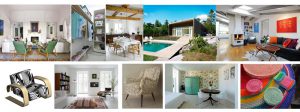
The countries that we think of when we talk about the Scandinavian style are Finland, Sweden, Norway and Denmark. Of course, in these countries the influences of the dominant European styles of past eras passed, however, the original way of life, national attachments and ideas about comfort left an imprint on the so-called scandinavian style, by which we rather mean a mixture of the country style of these countries, the way of the house and the concept of things. Here, environmental friendliness of things, an abundance of light wood, simple lines, light basic colors of walls and floors, broken by bright spots of national ornament used on wicker rugs, in rugs, pillows and bedspreads, are of particular value. In this style, cottages, saunas, country residences are often performed, where the style can be applied both in the architectural solution and in the interior.
East style
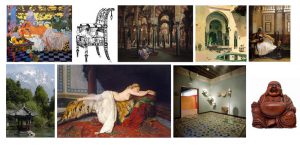
The Eastern style includes influences from China, India, Egypt, and the Middle and Far East. Interior items and household items play an important role here. Crafted carved furniture, inlaid with mother-of-pearl and ivory, screens, silk, an abundance of multi-colored carpets, mosaics on the floor and walls, chests, hand-painted boxes. A wide sofa covered with numerous pillows as a sign of comfort and relaxation is inherent in Indian interiors. Richly decorated lamps with elements of hammered metal and glass. An abundance of decorative items, dishes, hookahs, swords, etc. The colors are saturated, purple, red, yellow, turquoise, cobalt blue, green, gilding.
English style
The English style is a reproduction of the worldview and attitudes of the inhabitants of Foggy Albion. An important hallmark the quality of the materials is, therefore, these are often quite expensive interiors. Antiques are often used, as well as colonial-style items made of precious woods. The colonial style, in fact, is a sub-style of English, as it was formed in English interiors through the introduction of oriental luxury goods brought from the colonies. The interiors are full of textiles with floral motifs.
The walls are painted in warm colors, yellow, red, cream or green. Often found covered with fabric wall panels with the same motif as on curtains and upholstery. The floor is made of high quality wood. Often, a fireplace is established, both real and decorative, serving as a stand for candles. The floor is covered with dense carpets with oriental motives. You can also often find furniture upholstered in leather, perhaps slightly worn, but always of high quality. Lots of pillows, all kinds of coasters, under feet, under newspapers, under a fireplace broom, etc.

